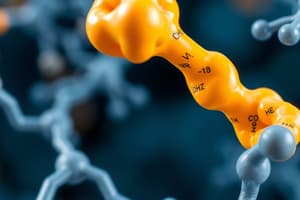Podcast
Questions and Answers
Quel est le produit final de la dégradation du glucose dans ce processus ?
Quel est le produit final de la dégradation du glucose dans ce processus ?
Combien de molécules de carbone contient le glucose avant la dégradation ?
Combien de molécules de carbone contient le glucose avant la dégradation ?
Quel type de molécules est produit en plus des pyruvates lors de la dégradation du glucose ?
Quel type de molécules est produit en plus des pyruvates lors de la dégradation du glucose ?
Quelles molécules agissent comme coenzymes dans le processus de dégradation du glucose ?
Quelles molécules agissent comme coenzymes dans le processus de dégradation du glucose ?
Signup and view all the answers
Combien de réactions enzymatiques sont impliquées dans la dégradation du glucose en pyruvate ?
Combien de réactions enzymatiques sont impliquées dans la dégradation du glucose en pyruvate ?
Signup and view all the answers
Study Notes
10 Enzyme-Catalyzed Reactions in Glycolysis
- Glycolysis is a metabolic pathway that converts glucose (a six-carbon sugar) into two molecules of pyruvate (a three-carbon molecule).
- This process produces energy-rich molecules like NADH and ATP.
- A total of 10 enzymes are involved in these reactions.
Reactions Overview
- The 10 reactions are divided into two phases:
- Energy Investment Phase: These initial steps require energy input in the form of ATP. Glucose is prepared for cleavage.
- Energy Payoff Phase: ATP and NADH are produced. The process harvests energy stored in glucose.
Detailed Overview of 10 Reactions
- Reaction 1: Hexokinase phosphorylates glucose to glucose-6-phosphate. This traps glucose inside the cell and initiates glycolysis.
- Reaction 2: Phosphoglucose isomerase converts glucose-6-phosphate to fructose-6-phosphate. Isomerization is crucial for subsequent steps.
- Reaction 3: Phosphofructokinase phosphorylates fructose-6-phosphate to fructose-1,6-bisphosphate. This is a key regulatory step, often controlled by feedback mechanisms.
- Reaction 4: Aldolase cleaves fructose-1,6-bisphosphate into two three-carbon molecules: glyceraldehyde-3-phosphate and dihydroxyacetone phosphate.
- Reaction 5: Triose phosphate isomerase converts dihydroxyacetone phosphate to glyceraldehyde-3-phosphate. This step ensures both three-carbon products can proceed in the next steps.
- Reaction 6: Glyceraldehyde-3-phosphate dehydrogenase oxidizes and phosphorylates glyceraldehyde-3-phosphate to 1,3-bisphosphoglycerate. NAD+ is reduced to NADH, storing energy.
- Reaction 7: Phosphoglycerate kinase transfers a phosphate group from 1,3-bisphosphoglycerate to ADP, generating ATP. This is a substrate-level phosphorylation reaction.
- Reaction 8: Phosphoglyceromutase relocates a phosphate group within 3-phosphoglycerate, creating 2-phosphoglycerate.
- Reaction 9: Enolase removes a water molecule from 2-phosphoglycerate, converting it to phosphoenolpyruvate (PEP). This creates a high-energy phosphate bond.
- Reaction 10: Pyruvate kinase transfers a phosphate group from PEP to ADP, generating another ATP molecule via substrate-level phosphorylation. Pyruvate is the final product.
Overall Energy Yield
- Glycolysis yields a net gain of 2 ATP molecules and 2 NADH molecules per glucose molecule.
- The NADH molecules carry protons and electrons that can be used in the electron transport chain to produce further ATP.
Studying That Suits You
Use AI to generate personalized quizzes and flashcards to suit your learning preferences.
Description
Ce quiz aborde les 10 réactions catalysées par des enzymes dans la glycolyse. Apprenez comment glucose est converti en pyruvate à travers les phases d'investissement et de profit énergétique. Testez vos connaissances sur ces processus métaboliques essentiels.




